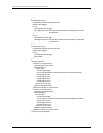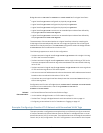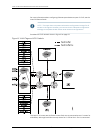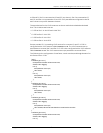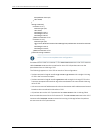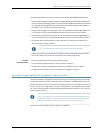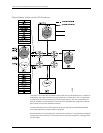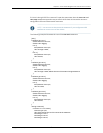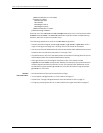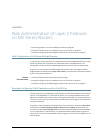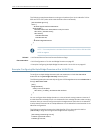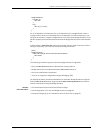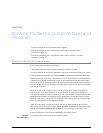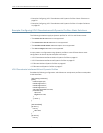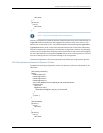
} # End of customer-c1-v1-to-v1000
customer-c1-v1500 {
instance-type vpls;
vlan-id 1500;
interface ge-1/0/0.11;
interface ge-6/0/0.11;
} # End of customer-c1-v1500
} # End of routing-instances
Note the use of the vlan-id all and vlan-id-range statements in the VPLS instance called
customer-c1-v1-to-v1000. The vlan-id all statement implicitly creates multiple learning
domains, each with its own normalized VLAN.
The following happens as a result of the vlan-id all configuration:
•
Packets received on logical interfaces ge-1/0/0.1 , or ge-2/0/0.1, or ge-3/0/0.1, with a
single VLAN tag in the range from 1 through 1000 in the frame are accepted.
•
Unknownsource MAC addressesand unknown destination MAC addresses arelearned
based on their normalized VLAN values of 1 through 1000.
•
All packets sent on the VPLS pseudowire have a normalized VLANtag after the source
MAC address field in the encapsulated Ethernet packet.
•
Although there are only three logical interfaces in the VPLS instance called
customer-c1-v1-to-v1000, the same MAC address (for example, M1) can be learned on
different logical interfaces for different VLANs. For example, MAC address M1 could
be learned on logical interface ge-1/0/0.1 for VLAN 500 and also on logical interface
ge-2/0/0.1 for VLAN 600.
Related
Documentation
• MX Series Ethernet Services Routers Solutions Page
• VLANs Within a Bridge Domain or VPLS Instance on page 43
• Packet Flow Through a Bridged Network with Normalized VLANs on page 44
• Configuring Learning Domains for VLAN IDs Bound to Logical Interfaces on page 47
Copyright © 2010, Juniper Networks, Inc.58
Junos 10.4 MX Series Ethernet Services Routers Solutions Guide



